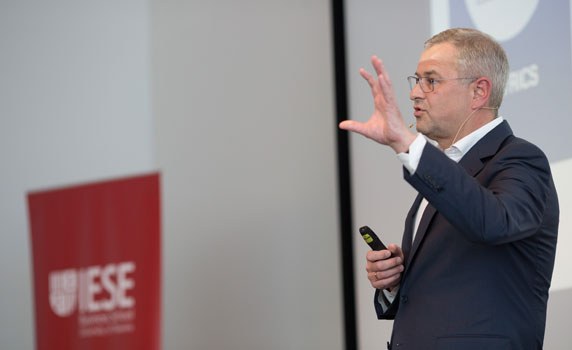
How do you turn losses of $533 million into profits of $461 million in 12 months?
By getting behind meaningful and company-wide change, says Søren Skou, CEO of Maersk Line.
And Skou knows what he’s talking about. Under his leadership, the world’s largest container-shipping company has experienced the kind of turnaround that makes news headlines around the world.
Talking at the IESE MBA50th anniversary celebrations in Copenhagen this month, Skou explained how a profound change in strategy brought a three-year run of major losses to an end. And radically improved the fortunes of a company that was losing $8 million a day when he took the helm as CEO in 2009.
Turning the Tides: A Three-Pronged Strategy
"Our first priority was to stop the bleeding. And that meant an immediate change of strategy."
The first change, a focus on short-term financial results, saw the company move from an "aggressive market growth approach" to a strategy of "growing with the market."
Skou and his team identified a number of measures to cut costs and increase revenues. Among these was a shift in market approach from delivering differentiated and premium services.
Although customers were happy with these services, they weren’t willing to pay for them. "So we turned our focus on our core products and cost improvements," said Skou.
Maersk Line increased its pricing by 25 percent – a move which the rest of the container shipping industry followed. Skou and his new leadership team also placed focus on capacity management of the ships; and driving cost improvements throughout the entire value chain.
"The short-term turnaround was successful and very effective. So much so, that by the second quarter of 2012, we had already generated a profit. We saw a surplus of $461 million by the end of 2013," says Skou.
Stage Two: Internal Organization
"No company is better than its people," says Skou. And in terms of strategy this meant addressing the mass of incoherent organizational initiatives, silos and corollary workforce issues that had accumulated during Maersk’s decline. This involved some hard choices for him and his team about how to structure the business, and which projects to shelve or get behind.
"In terms of its manpower, Maersk had traditionally recruited most of its management from within the organization. We decided to change this and implement a new strategy. We began by recruiting the competencies we needed both from within and externally, making our organization more competent and priming it for the challenges of the future."
It’s a move that has paid off. Elsewhere, he says, the focus on cost efficiency continues.
"We’re moving from cost improvements to cost leadership in the sector. And we’re seeing the dividends. Cost leadership is a core part of the Maersk Line strategy," says Skou.
Creating a strong organizational foundation built on a coherent structure has been a key factor in long-term success, according to Skou.
"Moving the organization in the same direction at the same time, has had an enormous impact on our capacity to achieve our objectives. And in a global organization, such as Maersk Line, that is no easy task."
It requires what Skou calls a "common culture and language" that transcends borders. Operational improvements such as company-wide operating systems have been deployed, together with the "three key elements that determine our common culture: Focus, simplicity and teamwork."
Sustainable, Profitable Growth
Skou and his team are keen to drive growth and ensure that Maersk remains not only the world’s largest, but also the best-performing container-shipping company. Defining the kind of company the team wanted to build, and the decisions needed to make this happen were key, says Skou.
"To sustain our competitive advantage we need to transform into a truly global company," he says. "For us this means learning from the likes of the airline sector: completely digitized and standardized booking systems will be a priority."
Beyond that, the focus remains of globalized processes and support functions, as well as sales and customer service.
"At the end of the day it’s about delivering what our customers want – commercial excellence."